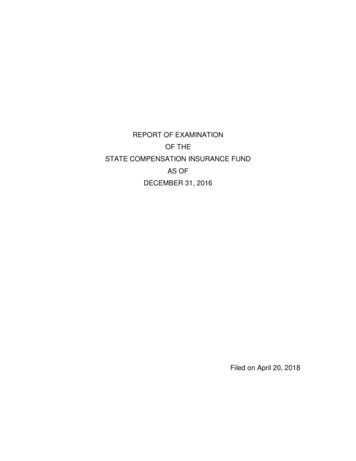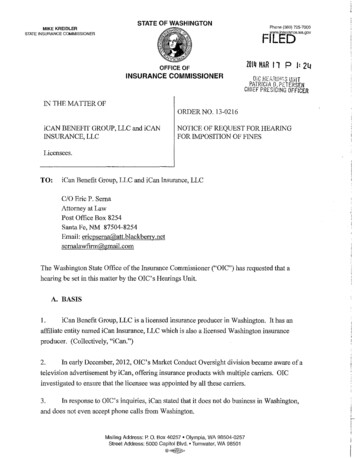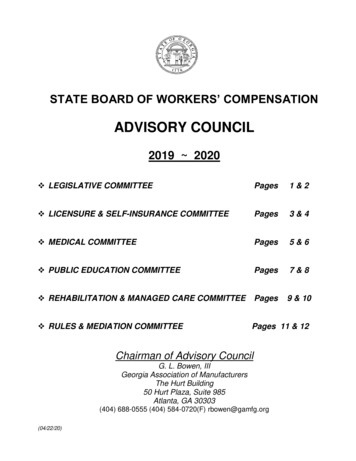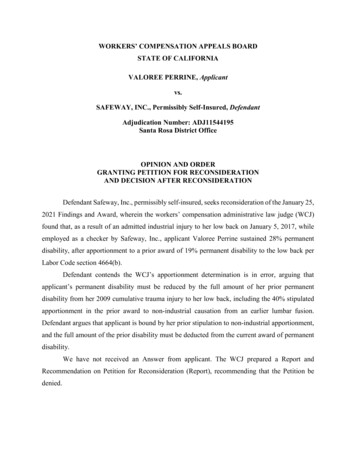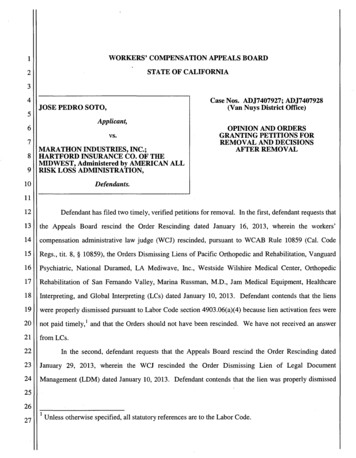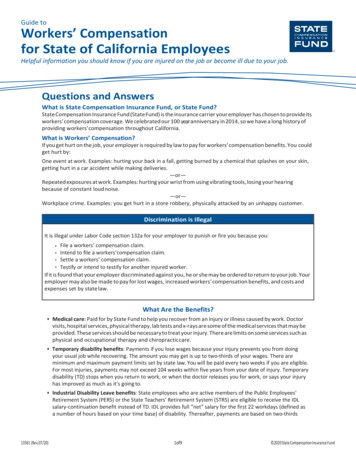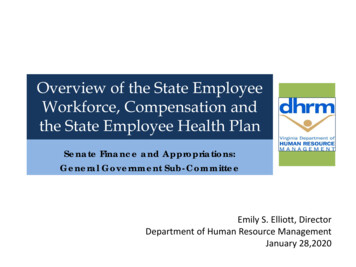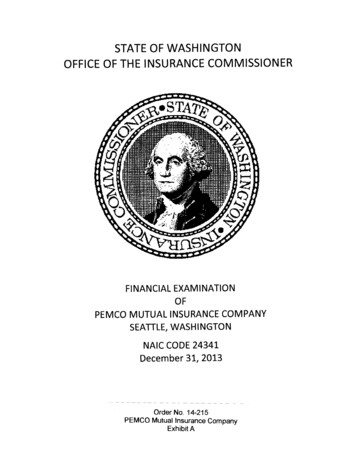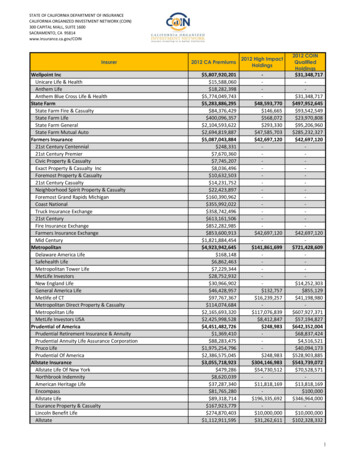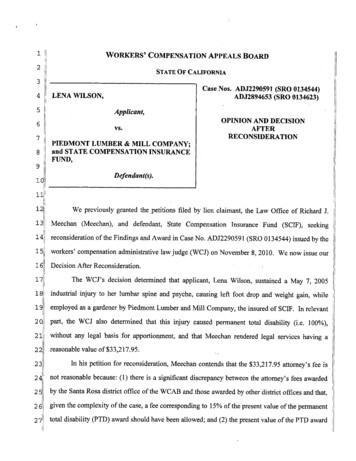
Transcription
1WORKERS' COMPENSATION APPEALS BOARD2STATE OF CALIFORNIA3456Case Nos. ADJ2290591 (SRO 0134544)ADJ2894653 (SRO 0134623)LENA WILSON,Applicant,vs.789101COPINION AND DECISIONAFTERRECONSIDERATIONPIEDMONT LUMBER & MILL COMPANY;and STATE COMPENSATION INSURANCEFUND,Defendant(s).12We previously granted the petitions filed by lien claimant, the Law Office of Richard J.13Meechan (Meechan), and defendant, State Compensation Insurance Fund (SCIF), seeking14reconsideration of the Findings and Award in Case No. ADJ2290591 (SRO 0134544) issued by the15workers' compensation administrative law judge (WCJ) on November 8, 2010. We now issue our16Decision After Reconsideration.17The WCJ's decision determined that applicant, Lena Wilson, sustained a May 7, 200518industrial injury to her lumbar spine and psyche, causing left foot drop and weight gain, while19employed as a gardener by Piedmont Lumber and Mill Company, the insured of SCIF. In relevant20part, the WCJ also determined that this injury caused permanent total disability (i.e. 100%),21without any legal basis for apportionment, and that Meechan rendered legal services having a22reasonable value of 33,217.95.23In his petition for reconsideration, Meechan contends that the 33,217.95 attorney's fee is24not reasonable because: (1) there is a significant discrepancy between the attorney's fees awarded25by the Santa Rosa district office of the WCAB and those awarded by other district offices and that,26given the complexity of the case, a fee corresponding to 15% of the present value of the permanent27total disability (PTD) award should have been allowed; and (2) the present value of the PTD award
1exceeds 815,000 after the expected annual cost of living adjustments (COLAs) under Labor Code2section 4659(c)' are applied. We have not received any answer to Meechan's petition.3In its petition for reconsideration, SCIF contends that the WCJ failed to indicate the basis4for the 100% permanent disability award, 2 in violation of section 5313 and WCAB Rule 107825[sic]. 3 Applicant filed an answer to SCIF's petition.6For the reasons stated in the Discussion section of the WCJ's Report and Recommendation7on Petition for Reconsideration (Report), at pages 4 through the last full paragraph of page 9,8which we adopt and incorporate by reference herein, we affirm the WCJ's determination that9applicant's May 7, 2005 injury caused permanent total disability, without any basis for10!apportionment. This disposes of SCIF's petition.11With respect to Meechan's petition, for the reasons that follow, we defer the reasonable12attorney's fee issue and remand that issue to the WCJ for further proceedings and a new decision134consistent with this opinion.14151. THE WCJ SHOULD HAVE AWARDED A 15% ATTORNEY'S FEE BECAUSE THISWAS A CASE OF ABOVE-AVERAGE COMPLEXITY.16When it awards an attorney's fee, the WCAB's basic statutory injunction is that the fee171All further statutory references are to the Labor Code, unless otherwise specified.182Defendant's petition captions Case No. ADJ 2894653 (SRO 0134623), in which the WCJ19determined that applicant sustained a June 9, 2005 injury resulting in a need for further medical treatmentbut no permanent disability. However, because defendant's principal argument is that the WCJ failed to20( explain how he found applicant to be 100% permanently disabled, we will treat defendant's petition ashaving been filed in Case No. ADJ2290591 (SRO 0134544).2123Current WCAB Rule 10782 pertains to vexatious litigants. Former Rule 10782, which hadrequired a WCJ to "prepare an opinion on decision setting forth clearly and concisely the reasons for thedecision made," was repealed in 1996. Defendant's counsel is hereby admonished for failing to keep evenremotely current on the applicable Rules.244222526273The WCJ's Report recites that Meechan "did not present any indication that he complied withBoard Rule 10778" (Cal. Code Regs., tit. 8, § 10778). However, Meechan's petition appends a copy, albeitunsigned, of a November 19, 2010 letter to applicant. The letter states that Meechan is seekingreconsideration of the WCJ's award of attorney's fees and that his petition "is in direct conflict to[applicant's] interests." The letter also advises applicant that, "[i]f you wish, you may consult with anotherattorney of your choice to discuss this matter." Accordingly, Meechan substantially complied with Rule10778.WILSON, Lena2
1awarded must be "reasonable." (Lab. Code, §§ 4903(c), 4906(a) & (d).)2In determining what constitutes a "reasonable" attorney's fee, the WCAB must take into3consideration: (1) the responsibility assumed by the attorney; (2) the care exercised by the attorney;4(3) the time expended by the attorney; and (4) the results obtained by the attorney. (Lab. Code, §54906(d); Cal. Code Regs., tit. 8, § 10775.) In addition, under WCAB Rule 10775, the WCAB6must make reference to the attorney's fee guidelines contained in its Policy and Procedure Manual7(P&P Manual). 5 (Cal. Code Regs., tit. 8, § 10775; see generally, e.g., Vierra v. Workers' Comp.8Appeals Bd (2007) 154 Cal.App.4th 1142, 1147-1148 & fn. 2 [72 Cal.Comp.Cases 1128, 1131 &9fn. 2]; Reich, Adell, Crost & Perry v. Workers' Comp. Appeals Bd (Jones) (1979) 99 Cal.App.3d10225 [44 Cal.Comp.Cases 1119, 1123]; Morgan, Beauzay, Hammer, Ezgar, Bledsoe & Rucka v.IWorkers' Comp. Appeals Bd (Schneiderman) (1976) 59 Cal.App.3d 353 [41 Cal.Comp.Cases 322,12323-3241.)13Among other things, the P&P Manual's attorney's fee guidelines provide that, in cases of14average complexity, the WCAB may allow an attorney's fee corresponding to 9% to 12% of thei5applicable benefits, i.e., 9% to 12% of the permanent disability award, plus 9% to 12% of any16temporary disability indemnity or out-of-pocket medical expenses that were obtained through the17attorney's efforts and that were not voluntarily furnished by the defendant.18above-average complexity, however, the WCAB may allow an attorney's fee that is in excess of1912% of the applicable benefits. Cases of above-average complexity include, but are not limited to:20(1) cases establishing a new or obscure theory of injury or law; (2) cases involving highly disputed211factual issues, where detailed investigation, interrogation of prospective witnesses, and22participation in lengthy hearings are involved; (3) cases involving highly disputed medical issues;23and (4) cases involving multiple defendants. The P&P Manual further provides that, in all cases,24"fees must be sufficient to encourage . competent attorneys to participate in this field of25practice." (See also, e.g., Robert G. Beloud, Inc. v. Workers' Comp. Appeals Bd. (Leinweber)2627Seesection1.140oftheP&PIn cases ofManualat:http://www.dir.ca.gov/wcab/WCAB Policy ProcedureManual/WCABPolicv ProcedureManual.html#29.WILSON, Lena3
1(1975) 50 Cal.App.3d 729, 737 [40 Cal.Comp.Cases 505, 510] ("The basis upon which fees are2fixed should not be so low as to discourage competent attorneys from accepting employment in3Workers' Compensation matters"); accord: Bentley v. Industrial Acc. Com. (Martin) (1946) 754Cal.App.2d 547, 550 [11 Cal.Comp.Cases 204, 206].)5We agree with Meechan that, in this case, a 12% fee is too low. Instead, given the care6exercised, the responsibility assumed, the time expended, the results obtained, and the difficult7nature of the factual and medical issues, this is a case of above-average complexity for which a815% fee is appropriate. The record establishes that this case has involved, among other things,9agreed medical evaluations in internal medicine and in psychiatry/neurology, a qualified medical1cevaluation in orthopedics, a report from a vocational expert, a deposition of the vocational expert,11and a full day of trial with multiple witnesses. Furthermore, Meechan obtained a 100% permanent12disability award notwithstanding the facts that the QME in orthopedics found only 52% whole13person impairment (WPI) 6 and the AME in psychiatry found only a GAF of 60-which, under the14Schedule for Rating Permanent Disabilities (Schedule), corresponds to 15% WPI.15Combined Values Chart of the Schedule, it is possible that the final permanent disability rating for16these two body parts might not have resulted even in a life pension, let alone a total permanent177disability indemnity award.Under the18Therefore, when this matter is returned to the WCJ for further proceedings, the WCJ shall19allow an attorney's fee corresponding to 15% of the relevant benefits, taking into consideration the2021discussion that follows.//2223This 52% WPI might even be less if Dr. Morley's February 6, 2008 amendment of his October 2,2007 report is taken into account.2476A very rough and informal rating might be:2515.03.00.00- 52- [5166- 491H- 59- 592614.01.00.00- 18- [8]25 -491D-21 - 212759 C 21 68 FINAL PERMANENT DISABILITYWILSON, Lena4
1234II.THE CASE IS RETURNED TO THE TRIAL LEVEL FOR FURTHERPROCEEDINGS ON THE PRESENT VALUE OF THE DISABILITY AWARD TOWHICH THE 15% FEE SHOULD APPLY AND FOR CONSIDERATION OF OTHERFACTORS.5A. The Disability Evaluation Unit Must Recalculate the Present Value of Applicant'sPermanent Total Disability Indemnity Award, Taking into Account the COLAs that SheMay Reasonably Be Expected to Receive under Section 4659(c) during Her Anticipated Life6As observed above, the WCJ awarded a 33,217.95 attorney's fee, which is 12% of the7 276,816.22 present value of applicant's PTD award, as calculated by the Disability Evaluation8Unit (DEU). In making this present value estimate, the DEU assumed that applicant's PTD rate9would remain constant at 253.33 per week during her expected life. However, for PTD awards,1COsection 4659(c) provides for an annual COLA "equal to the percentage increase in the 'state11average weekly wage' [SAWW] as compared to the prior year." The DEU's present value estimate12did not assume any average annual SAWW increase-and, therefore, did not assume any average13annual COLA-over the remainder of applicant's expected life.14In his petition, Meechan asserts that the present value of applicant's PTD award exceeds15 815,000. The petition states that this figure is derived from calculations Meechan obtained from16Blair Megowan (Megowan), the former DEU manager. These calculations, however, are not in17evidence or appended to the petition.1819The initial determination of the present value of a PTD award---or of a permanentpartial disability (PPD) award with a life pension-is done by the DEU.In making its20ý present value calculation, Rule 10169 requires the DEU to utilize the January 200121Commutation22(Cal. Code Regs., tit. 8, § 10169; see also § oratesbyreference.Obviously, though, the January 200123[ Commutation Instructions do not take into account the 2002 amendment to section 4659 that24provided for COLAs on PPD awards and life pensions for injuries occurring on or after January 1,25262003. (See Lab. Code, § 4659(c) [Stats. 2002, chap. 6, § 67 (AB 749)].)Nevertheless, in making present value calculations under Rules 10169 and 10169.1, the278The January 2001 Commutation Instructions can be found at http://www.dir.ca.zov/dwc/CommIlnst.pdf.WILSON, Lena5
1DEU should not disregard subsequent changes in the law. This is because a subsequently enacted2statute trumps a regulation to the extent they are inconsistent. (Juarez v. 21st Century Ins. Co.3(2003) 105 Cal.App.4th 371, 376 ["[a] statute overrides any inconsistent provision in a4regulation"]; Sheyko v. Saenz (2003) 112 Cal.App.4th 675, 687 ["a regulation . cannot impede5the force of the statute"]; see also Gov. Code, § 11342.2 ["no regulation adopted is valid or6effective unless consistent and not in conflict with the statute"].) Therefore, when calculating the7present value of any PTD or life pension awards, the DEU should determine whether any estimated8average annual COLA should be applied.9Indeed, it appears the DEU's current policy is to apply an estimated average annual COLA10in calculating present value. In this regard, we take judicial notice (see Evid. Code, § 452(c)) of1ithe written educonfl5/Commutations/Commnutationspdf),141when Megowan was still the DEU Manager. 9 Those written materials state that the average annual15SAWW increase over the prior 50 years was approximately 4.7% and indicate that, in the absence1617of a request by the WCJ or the parties to use a different percentage, the DEU will use 4.7% as theestimated average annual COLA in determining the present value of a PTD or life pension award.18(Id. at p. 3.)10 We also take judicial notice (see Evid. Code, §§ 451(a), 452(a), (c), & (d)) of prior19decisions of the Appeals Board where Megowan and the DEU utilized a 4.7% average future20COLA on the basis that this has been California's 50-year average for annual changes in the21SAWW. (E.g., Bacha v. State of California (2009) 2009 Cal. Wrk. Comp. P.D. LEXIS 613on Commutationsfrom the statewide 15th Annualgiven by the Division of Workers'EducationalCompensation (DWC) in 2008 (seewhich were prepared22ý (Appeals Board panel); Pan v. State of California (2007) 2007 Cal. Wrk. Comp. P.D. LEXIS 22723(Appeals Board panel); Munoz v. Barrocas Construction (2007) 2007 Cal. Wrk. Comp. P.D.24LEXIS 197 (Appeals Board panel).)25Of course, this 4.7% average future COLA has not been adopted as a regulation.269Our understanding is that Megowan retired as the DEU Manager sometime in mid-2010.2710See also http://www.dir.ca.gov/DWC/educonfl 7/Commutations/CommutationsandSAWW.pdf, at p. 4.WILSON, Lena6
1Nevertheless, the 4.7% figure appears to represent an effort by the DEU and Megowan, when he2was the statewide DEU manager, to informally establish a reasonable estimated average future3COLA that can be used in PTD and life pension cases state-wide without delaying resolution of4those cases-and without flooding the WCAB's calendar-because of litigation over this issue.5As other Appeals Board panels have said in the past:6789101112"Where life expectancies are used for purposes of establishing the presentvalue of an award, and in order to comply with Labor Code section 4659(c),some type of formula or approach is necessary to establish a percentage figurefor purposes of the statewide weekly wages factor, because the statute in factrequires that an injured worker's 100% permanent disability indemnity ratewill be continually adjusted in the future. In the absence of evidence to thecontrary, the use of the 50 year average of 4.7% is a rational and reasonableformula to satisfy the requirements of section 4659(c) and to determine thepresent value of the award and the correct attorney's fee." (Pan, supra, 2007Cal. Wrk. Comp. P.D. LEXIS 227, at pp. 6-7; accord: Bacha,supra, 2009 Cal.Wrk. Comp. P.D. LEXIS 613, at pp. 9-10.)13Indeed, in the absence of other evidence, we presume that the DEU and Megowan regularly14'performed their official duties when they calculated a 4.7% average future COLA based on annual15SAWW increases in California over the past 50 years. (Evid. Code, § 664; see also, e.g., Inyo16Citizens for Better Planning v. Inyo County Bd. of Supervisors (2009) 180 Cal.App.4th 1, 12,1713-14 [presumption that county officials regularly performed their duty of calculating net acreage18of property]; Santa Ana Hospital Medical Center v. Belsh (1997) 56 Cal.App.4th 819, 835-83619! [presumption that Department of Health Services regularly performed its duty of calculating20"disproportionate share hospital" reimbursement].)21Still, just because we have taken judicial notice of this 4.7% average future COLA and will2223assume it is correct in the absence of other evidence, this does not mean the 4.7% figure isabsolute. A rater who prepares a present value calculation is free to use a different figure. For one,24as already observed, the 4.7% average future COLA was not adopted by regulation. Therefore, it is25 not mandatory. For another, the 4.7% average future COLA is predicated on the assumption that2627the average annual increase in the SAWW over the preceding 50 years fairly reflects what futureincreases will be. In this regard, we recognize that the percentage increase in the SAWW has beenWILSON, Lena7
1almost uniformly less than 4.7% over the last eight years, from 2004 through 2011. The only year2during that span in which the SAWW increased by more than 4.7% was 2007, which saw a 4.96%3increase. However, the percentage increases of the SAWW for the years42006,5and 2.99%; moreover, the years 2004 and 2011 had no increase in the SAWW. ons/ComrmutationsandSAWW.pdf,7Workers' Compensation Laws of California (LexisNexis) (2011 ed.), at p. 1660, Table 14.)"18Finally, the 50-year average annual SAWW is a moving target because it may change somewhat9when a new year of SAWW data comes in. In fact, more recent materials from the DEU assume an10average annual increase in the SAWW of 4.6% over the 50-year period from 1952 through 2011.1211We infer that this slightly lower assumed SAWW percentage takes into account that there was no12SAWW increase in 01%,2005,3.93%,4.55%,at p. 3; TheTherefore, we will return the matter to the WCJ to refer this matter to the DEU to calculate14the present value of applicant's PTD award, using whatever average future COLA, if any, that the15/t/16/1718IIt192021These figures are all based on DWC Newsline announcements regarding the SAWW for thoseyears: http://www.dir.ca.gov/dwc/dwc newslines/2010/Newsline 56-10.pdf (for 2011);22 http://www.dir.ca.gov/dwc/dwc newslines/2009/Newsline 52-09.df (for2010);http://www.dir.ca.pgov/dwc/dwc news 1ines/2008/Newsline 66-08.pdf (for 2009);231 http://www.dir.ca.gov/dwc/dwc newslines/2007/Newsline 66-07.pdf (for 2008);http://www.dir.ca.gyov/dwc/dwc news Iines/2006/Newsline 54-06.pdf (for 2007);24 http://www.dir.ca.gov/dwc/dwc newslines/2005/Newsline 81-05.html (for 2006);http://www.dir.ca.gov/dwc/dwc newslines/Newsline 63-04.html (for 2005); and25 http://www.dir.ca.gov/dwc/dwc newslines/Newsline 18-03.html (for 2004).262712SeetheDEUCommutationTraining materials thathave been mutations/Commutations.pdf p. 14 (slide 28).WILSON, Lena8
1rater deems appropriate.132We recognize the WCJ's decision did not specify a start date for applicant's annual3COLAs, but instead provided that her PTD indemnity payments would be "subject to adjustments4under Labor Code §4659(c)." Presumably, this is because the question of when a COLA should5start is currently pending before the Supreme Court in Duncan v. Workers' Comp. Appeals Rd.6(XYZZXS102), S l79194. If the Supreme Court's decision in Duncan has not issued by the time of7the present value calculation (which appears likely, since the Supreme Court has not even set a date8for oral argument), the DEU should issue three alternative present value calculations using9the three possible start dates: (1) January 1, 2004;14 (2) the first January 1 after the date of injury;' 510and11http://www.dir.ca.gov/DWC/educonfl 8/Commutations/Commutations.pdf, at p. 5 [slide rt.16(See12Once the DEU has made its present value calculation(s), the calculation(s) should be served13on the parties, thereby giving them the opportunity to object. We will not prescribe when and how14service of the present value calculation(s) should be effected; however, we suggest it be done15through a notice of intention (NIT) from the WCJ indicating that the calculation(s) will be accepted1613171the parties and Meechan to stipulate to the use of a particular estimated average annual COLA.Nevertheless, the WCJ should proceed extremely cautiously before accepting any such stipulation. (SeeLab. Code, § 5702; Cal. Code Regs., tit. 8, § 10497.) This is because app
2 5 by the Santa Rosa district office of WCAB and those awarded by other district offices and that, 2 6 given the complexity of the case, a fee corresponding to 15% the present value the permanent 27 total disability (PTD) award should have
